EBR charges a service fee to manufacturers to produce ebike reviews and videos, this began in 2018. It’s the same flat fee for each bike, and it helps us to keep the site going while limiting ad clutter. We appreciate the opportunity to serve you with our opinions and data but respect your right to know that we receive compensation :)
Hi there! Hopefully you’re having an awesome day! This is Brent. Today I’m reviewing the Rebel from CIVI BIKES, a folding fat tire electric bike with a stock price of $1,299 and the option to add fenders, a front basket and a rear rack for an additional $150.00. This is the second bike from CIVI BIKES I’ve been able to review, the first being the Predator model. While the Rebel is a folding electric bike, it’s still quite large with an overall unfolded length of 68.5 inches and a width of 24.75 inches. It feels like the Rebel is geared towards utility use and has a powerful 500 watt geared hub motor that gets a mechanical advantage from the smaller 20″ wheel size, a higher than average battery capacity of 624 watt hours, mechanical disc brakes in the front and rear, a Shimano Altus derailleur, and sturdy locking mechanisms to keep everything in place when it’s unfolded and being ridden. The Rebel only comes in one frame size but there are two different colors: 17 inches and Pearl White or Matte Black, respectively. The single frame size does limit who can comfortably fit this bike, though the telescoping stem does allow for a fair amount of flexibility for reach, and the saddle does drop all the down to the seat post clamp; these two features should help accommodate extra tall and extra short riders and hopefully can compensate a bit for the single frame size.
Right now, CIVI BIKES is a direct-order only company, but they do plan to add at least 50 retailers across the United States in the near future. CIVI BIKES is also a relatively new company based in Ontario, California, they’ve been producing electric bikes in China for over a decade and have leaned on that experience to establish a direct-order brand in the United States. Currently, CIVI BIKES only ships to the United States, Canada and Germany, which limits who can own one of these bikes, but at least shipping is free! That’s a huge bonus, as oftentimes direct-order only companies will have low pricing on their bikes, but then charge several hundred dollars to ship. Being a direct-order only comes with one huge pro and a couple of potential cons, all of which we’ve talked about in detail in a recent video on the dangers of buying direct-order. The biggest pro, usually, is the savings in cost. Electric bikes purchased from direct-order only companies are, generally speaking, quite a bit less than their equivalent counterparts in retail shops. This makes sense given direct-order only companies are able to save big by eliminating brick-and-mortar shops, fewer employees and cutting other types of overhead. However, there are some risks that come along with buying direct-order only as well. First of all, buying direct-order only means I have to assemble the bike myself, which can take anywhere from 15 minutes to a couple of hours depending on fit and finish and overall difficulty of assembly. For the Rebel, I spent about an hour and half. Most of that time was spent figuring out how to fit together the front basket, rear rack, and fenders, but it only took me about 15 minutes to get the bike itself assembled. Overall I’d rank this bike as being moderately difficult and moderately time consuming to assemble. Another potential con is the overall fit and finish of the electric bike. Sometimes I’ve found the pieces don’t fit quite right, the frame might have scratches, parts can be damaged and occasionally I’ve even seen different components on the actual bike compared to what was advertised on the company website. With the Rebel, that was only partially the case, with the biggest issue being the fit of the rear rack, which feels as though it’s a bit off. I struggled to get it to fit correctly and was unable to secure one attachment point altogether. With assistance this would have been less of an issue, but by myself I just wasn’t able to do it. Aside from that, however, everything else fit nicely and there was no damage to the bike or any of its components.
Before I dive deeper into this review, I want to digress a bit to give some assembly tips. First, and thankfully, CIVI BIKES does have assembly video tutorials on their website, which is how I managed to figure out what went where. Where these videos fall short, however, is specifying order of assembly. So, my bike came with the optional fenders, rear rack and front basket, so let’s talk about those. Both the front basket and fenders share attachment points, and this is the order and way I believe they should be installed: Once the seat post and handlebars are attached, flip the bike over and mount the front wheel. Orient the washers, but don’t secure the wheel with the nuts yet. Install the front fender (as well as the support bracket for the front fender) and support arms on the front basket and place the end of the arms with the larger hole over the skewer and then secure everything with the nuts. Now, flip the bike over secure the front basket and front fender (which should at this point be one piece) into the fork. Woohoo! Now, hopefully you won’t have to take off the front basket to install the fender like I did. :) Installing the rear rack is far more straightforward, though this is where I ran into the issue of the tolerances being too wide and not being able to fit one of the arms onto the frame. Again, if you need any additional clarification, please refer to the video review and/or to the video tutorials from CIVI BIKES for the rear rack and fender kit and front basket.
Driving this bike to a top speed of roughly 20 mph is a Bafang 50 watt geared hub motor in the rear wheel. This motor has 80 Newton meters of torque and a fair amount of overall power. The top throttle only and pedal assist speed of 20 mph keeps the Rebel as a class 2 electric bike, making it legal to ride in more areas compared to class 3 and class 4 electric bikes. Still, it’s a good idea to check state and local laws before hitting the open roads because some places (unfortunately) don’t allow electric bikes with throttles to be ridden… period. The Rebel has an internal, sealed 12-magnet cadence sensor, and although this is a higher resolution sensor compared to 6 and 8 magnet sensors, there’s still a delay from the time I start and stop pedaling and the time the motor spits out power and shuts off, respectively. This is pretty common for cadence sensors, which is why I prefer torque sensors, although those typically cost more. This lag is especially pronounced in higher gears at slow speeds where it takes longer for the cranks revolve and trigger the sensor. Thankfully, the throttle is live at 0 mph on this bike so I can override the cadence sensor with a twist of my wrist. I can also manually shut off the motor if I need to by slightly depressing either brake lever, thereby activating the motor inhibitors, a great safety that also helps to ensure the shortest possible stopping distance. Note that the motor and disc brakes on this ebike benefit greatly from a mechanical advantage over the smaller wheel size. Big wheels take more effort to turn for hub motors, because they do not send power through the geared drivetrain like a mid-motor… overall, the bike feels very powerful and stopped well. This is important, given the heavier build and heavier battery pack.
Powering the Rebel and the compact LCD display unit is a 48 volt, 624 watt hour locking, removable seat-tube mounted Lithium-ion battery pack. The charging port and key hole are located on the top of the battery so there’s little chance of snagging the power cord while charing the battery on the frame. The battery can also be charged separately from the bike by removing the seat post and saddle to clear a path, and then removing the battery. It’s an extra step to remove the seat each time you want to take off the battery, but it does allow for it to be charged separately and just as importantly, allows the battery to be more easily stored in a cool dry location, just the kind of conditions batteries like best. It should be noted however that the key must remain in the key hole to keep the battery on. On silverfish style batteries like this that are mounted behind the seat tube, there’s potential for snagging the key while pedaling. This is a problem I have most likely due to my big ol’ hobbit feet. It can also result in damaging the key, or even the battery, rendering the bike inoperable, so just watch out for that and maybe don’t put all of your other keys on a big keychain attached to the key! The Rebel comes with two keys, so you could just leave one in the battery at all times… and then take it off and be careful not to lose it, or use a Caribbean, when parking at public racks. Given that this is the same motor and same battery watt hours as the Predator full sized electric fat bike, I gave it the same estimated range of 15 to 30 miles, depending largely on rider specifics like weight, how heavy a rider is on the throttle, what level of pedal assist is being used and the terrain. Another pretty big variable here for the range is going to be the fat tires. Being that they’re 20 inches by 4 inches wide, there’s a lot of surface area even when they’re fully pressurized to 20 PSI. If I were to air them down to 5 PSI for more traction in soggy terrain, I would greatly increase my tire patch but also greatly increase the rolling resistance and efficiency of the tires, thereby greatly decreasing my range. So, all that to be said, the range estimate here is just that, an estimate. :) The display on the Rebel can’t be angled or removed without tools, so it can’t easily be angled to avoid glare or removed when parking this bike at a public bike rack, leaving the screen vulnerable to be scratched by other bikes. Still, I didn’t have an issue seeing this display clearly even in direct sunlight. There are no lights on the Rebel, and no USB Type A port on the display or the battery, so any aftermarket lights will need to have independent power supplies. The charger for the Rebel is a standard 2 amp output charger and I estimate it will take about 5 hours to fully charge.
Powering the Rebel up requires a long press of the M button on the display. The display goes through a quick bootup sequence and then comes to life. As I mentioned earlier, the throttle here is live at 0 mph and also as soon as the bike is turned on (it always reverts to pedal assist level 1 upon bootup). This is a wonderful feature as it allows me to bypass the lag from the cadence sensor and immediately unleash full power to quickly get across crosswalks, start at the bottom of the hill while in a high gear and most importantly to me, it allows me to assist the bike up stairs, which makes a huge difference when it weighs 60 pounds! The other side of this coin though, is that a live throttle at 0 mph makes an accidental activation rather easy. In fact, this happened to me literally yesterday as I was moving the Predator (which also has a live throttle at 0 mph) up some stairs. Once I reached the top of the stairs I was in an awkward position and my weight was on the handlebars. I activated the throttle accidentally and got dragged right into the side of my car (thankfully it wasn’t somebody else’s car!). No injuries or anything, or even any damage to my car, but the point is, please be careful with this because it can definitely happen! Speaking of no lights and safety, since the Rebel doesn’t come with lights (and they’re not available in the accessories section from CIVI BIKES) it might be a good idea to grab something aftermarket if you’re like me and enjoy sunset rides. This will be especially important for the matte black color, which already has limited visibility in low light conditions.
Overall, the Rebel offers a fair degree of utility in a relatively compact package. The mid-stem frame design is approachable, and the folding joint isn’t super wide so your knees shouldn’t bonk too much when pedaling (but still be careful). There’s no rated weight limit for the front basket or rear cargo rack, but they do feel quite secure and have several attachment points to the frame. However, one thing to note about the basket is that since it’s mounted to the forks, any weight that is added to it will become pronounced while steering, and any cargo inside the basket will also sway whenever the handlebars are turned. I like how easily the Rebel folds and especially like the safety mechanism on the folding latch, which really does a good job of keeping the frame locked even if the latch becomes partially loose. The gusset on the top tube (top of the frame?) also doubles as a handle and makes it easy to pick up and carry the Rebel if needed, though that 60 pounds still gets heavy fast. There’s also a series of grooves beneath the saddle which serve as another grab point when moving the bike, a small feature that I really like. The fat tires along with the front basket and rear rack means this ebike would do well for folks who like to camp and travel with RVs. This bike could easily be folded up and stowed in a RV storage compartment, or even just thrown in the back seat of a car, and then quickly unfolded and be ready to ride through some moderate off-road trails. If you are folding and transporting a lot, consider using a towel between the frame and around the racks and fenders to keep them from getting scratched up… I usually take the battery out before lifting ebikes, just to reduce the potential for a hurt back. Although the one frame size is limiting, the telescoping stem and the fully droppable saddle does help to compensate for that. Assembling the bike itself was quick and easy, though I did struggle a bit to install the fenders, front basket and especially the rear rack. If you’re looking for a folding electric bike that can carry some cargo and be used in the city and on some mild off-road trails but that doesn’t make you feel like you’re riding a circus bike with super tiny wheels and a small frame, the Rebel feels like it would be a good fit. I want to thank CIVI BIKES for partnering with me on this review and if you have any questions or comments, please feel free to leave them here in the comments section of the YouTube review and Court and I will do our best to answer them, you can also connect directly in our CIVI BIKES forums. Thank you for stopping by and I hope you have an awesome day, and of course if you’re going out to ride, have fun and ride safe!
Pros:
- 1 year comprehensive warranty, plus lifetime warranty on the frame, plus free shipping makes for a handful of bonuses that not every direct-order only electric bike company offers
- Throttle is live from 0 mph, making it easy to override the delay from the cadence sensor when trying to quickly cross a crosswalk, starting at the bottom of a hill in a high gear or assisting the bike up stairs
- Telescoping stem can extend an additional 185 mm, increasing minimum height from 260 mm height to a maximum 445 mm height, this also increase the reach from 23.5 inches to 25.5 inches, allowing a wider range of riders to comfortably ride this frame, stem can also fold down with a quick release lever to make the bike even more compact when folded
- Display is compact and also incorporates the button pad, leaving more room on the handlebars for aftermarket accessories like a headlight, phone holder or bluetooth speaker
- Brake levers have rubberized edge make them easy to get a firm grip on, they also activate the motor inhibitors, ensuring the shortest possible stopping distance and allowing the rider to manually override the motor when navigating technical terrain at slow speeds
- Wire management is on point with just the right amount of zip-ties, which are cut cleanly and shortly, and some nylon mesh around the bulkiest part of the wires
- Front basket and fenders attach securely to the frame of the bike and feels like they aren’t going anywhere, basket it sized nicely with enough room to fit a grocery bag but not so big that it will overburden the steering, steel fenders are more rigid than plastic and rattle less
- 160mm mechanical disc brakes in the front and rear provide ample stopping power and are easier to repair and work on compared to hydraulic disc brakes, they get a mechanical advantage on the Rebel 1.0 because it has smaller 20″ wheels
- 20 inch by 4 inch wide fat tires have large air volume and add some suspension qualities to the Rebel, wide tire patch also allows the bike to float over soggy terrain that regular sized tires might sink into, smaller diameter also gives the motor more a mechanical advantage compared to full-sized tires
- Frame feels pretty sturdy for a folding electric bike, with a handful of gussets for added structural integrity and a handlebar built into the top of the frame for easy carrying as well, locking mechanisms are also quite secure and leave little chance for the frame to collapse except for in the most extreme riding conditions
- Folding pedals shave off another few inches from the width of the bike when it’s folded, making it easier to store in those extra tight spaces
- Double-sided chainring guard helps keep the chain locked in place, reducing the chance of it popping off towards the inside or outside
- Steel cage at the bottom of the frame serves as a stand for when the bike is folded so it can balance upright without assistance
- Seat post drops pretty much all the way to the clamp making for a relatively short minimum saddle height, this is especially important for riders with shorter inseams, quick release seat post clamp means saddle height can be adjusted on the fly without tools, saddle has a grooved section underneath that serves as a good place to grab hold of when moving the bike
- Key hole and charging port are located at the top of the battery, keeping the power cord and keys clear of the cranks when charging, this reduces the chance of getting the cord snagged in the cranks and potentially damaging the cord and battery
- Cranks are full sized at 170mm in length even though it’s a folding bike, so the stroke doesn’t feel cramped, this should help maximize pedal efficiency
- Aluminum rear rack attaches to four separate points on the frame and feels sturdy, rack has a few cutouts for bungies to help secure cargo as well
- Shimano Altus derailleur is an upgrade from the Tourney, which is the most entry level derailleur from Shimano
- Adjustable length kickstand is placed at the rear of the bike and stays clear of the cranks, so there’s no pedal lock which is especially important for a bike like this that might need to be pulled backwards from a tight storage space
Cons:
- Grips are non-locking and the stitching feels like it could wear out over time, it’s a cheaper part but is also inexpensive to upgrade if you want
- Shimano SIS Index thumb shifters are an entry level component and may require a repositioning of the hand to access, some riders may find this difficult or uncomfortable but they do it to make room for the twist throttle
- Flick bell is pretty far towards the middle of the handlebars is even more difficult to access than the thumb shifters, there are no magnets or bungees to keep the bike folded, the rims aren’t punched out and thus, weigh a bit more
- Mechanical disc brakes require more pressure to get maximum stopping power compared to hydraulic disc brakes, riders with arthritis or hand injuries, or riders with extra small or extra small hands may find it difficult to exert the required pressure, brake lever positioning also can’t be adjusted here so some riders may find the reach distance undesirable, they also offer less stopping power overall compared to hydraulic disc brakes
- Display can’t be angled or removed without tools, making angling for glare or taking the display off when leaving the bike at a public bike rack a hassle, display and battery also d not have a USB Type A port to power/charge accessories
- Telescoping stem stretches the wires when raised to the maximum height, and in this position there is even more pressure placed on the wires when the handlebars are turned, this can result in damage to the electrical components and may even render parts of the electrical system inoperable… so just be careful and thoughtful when raising the stem, single frame size means that fit is somewhat limited
- Front aluminum basket is mounted to the forks, making any weight added to the basket felt during steering, items in basket will also shift when the handlebars are turned
- Steel fenders can rust if they are scratched through the paint, also adds more weight compared to aluminum or plastic fenders to an already heavy bike, but they are sturdy and don’t rattle around as much
- Latch to fold the bike requires quite a bit of pressure to release, and some riders may find it difficult to undo the latch, I usually take the battery off when folding and lifting… but that requires removing the seat as well because this one doesn’t have a flip-up seat clamp
- Double-sided plastic chainring guard is likely to break in the event of a hard strike and does little in the way of actually protecting the chainring teeth from damage vs. an alloy guard
- Cadence sensor has some lag from the time the cranks start and stop moving to the time the motor actually activates and deactivates, this is especially pronounced in higher gears at lower speeds
- Key must be left inserted in the battery during operation, this can result in snags or heel strikes when pedaling
- Rear rack had low tolerances and didn’t fit the frame quite right, I was unable to properly install the rear rack during assembly and this added time and frustration
- No steel derailleur cage leaves the derailleur and power cable vulnerable to damage in the event of a strike or snag off-road or during transport, and lack of bosses there will make installing an aftermarket one difficult… no bottle cage bosses on the frame (though this is not uncommon for folding electric bikes)
- No lights and the matte black color leaves a low visible footprint in low light conditions, installation of the front basket means a light will need to be mounted to the handlebars or on a helmet
- Direct-order only means this bike can’t be tested before purchasing, so there’s really no way to know for sure if the frame will fit a specific rider, or if the bike will ride the way a rider wants, direct-order only also comes with its fair share of potential pitfalls and dangers
Resources:
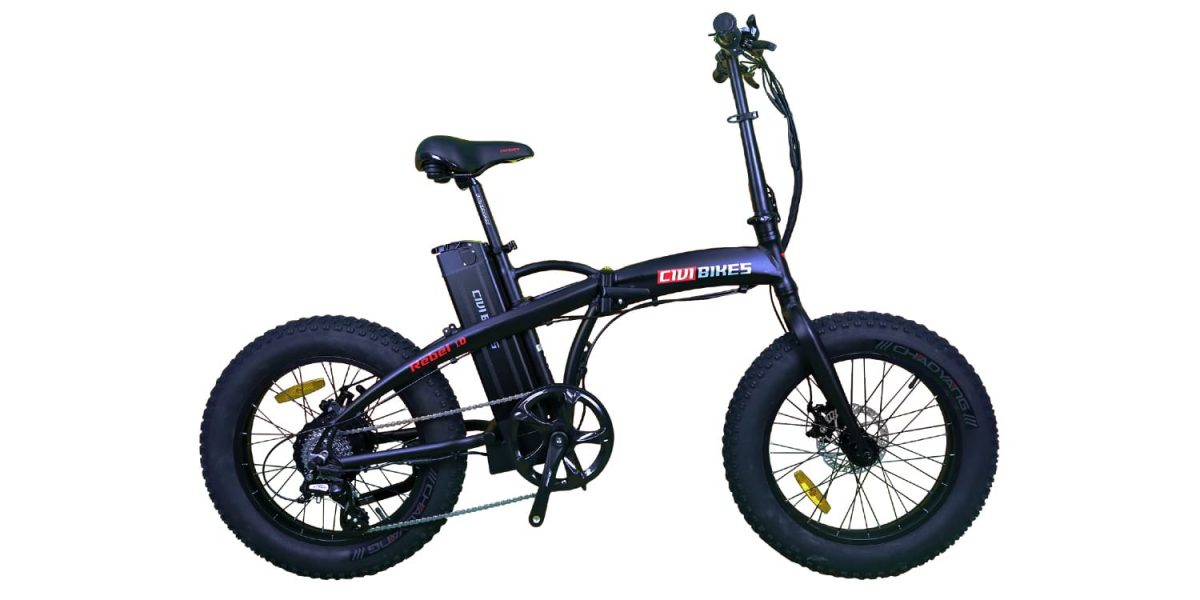











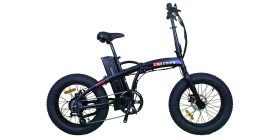
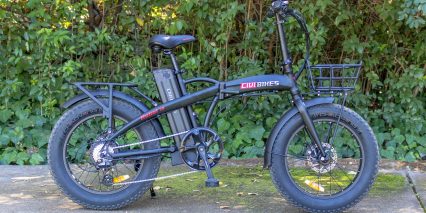
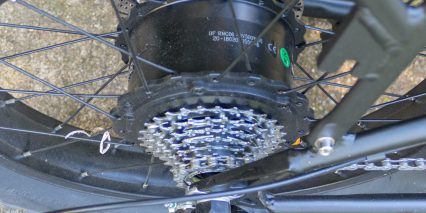
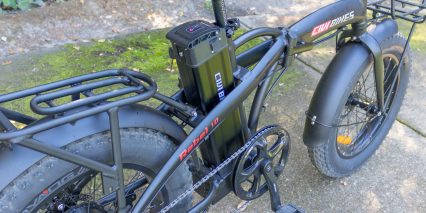
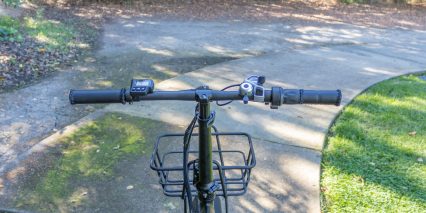
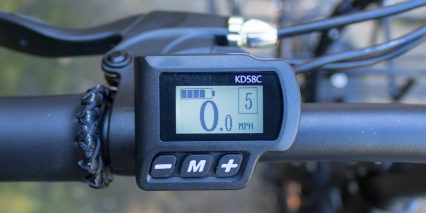
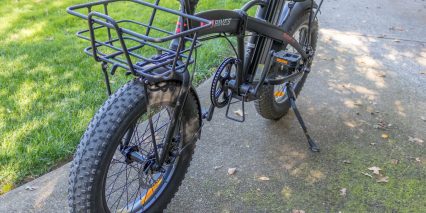

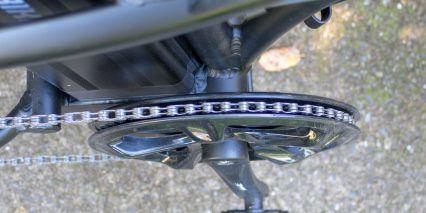
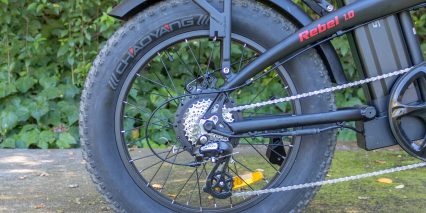
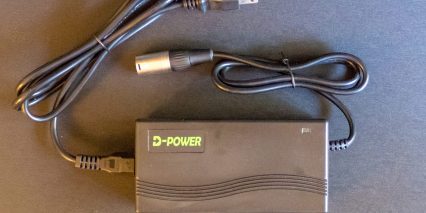
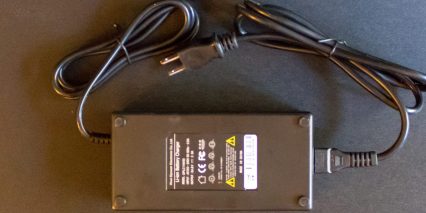

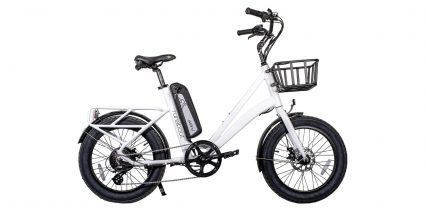
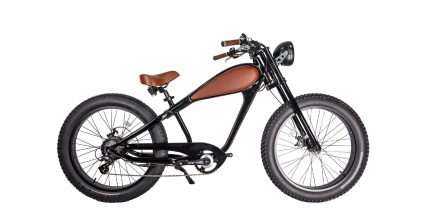

Be the First to Post a Comment